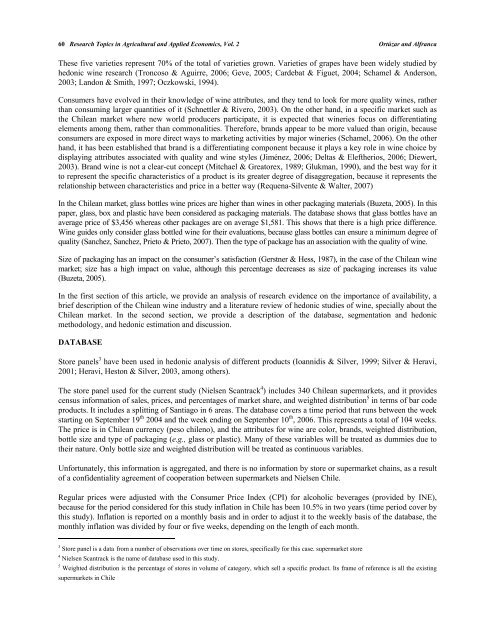chapter 2 - Bentham Science
chapter 2 - Bentham Science
chapter 2 - Bentham Science
You also want an ePaper? Increase the reach of your titles
YUMPU automatically turns print PDFs into web optimized ePapers that Google loves.
60 Research Topics in Agricultural and Applied Economics, Vol. 2 Ortúzar and Alfranca<br />
These five varieties represent 70% of the total of varieties grown. Varieties of grapes have been widely studied by<br />
hedonic wine research (Troncoso & Aguirre, 2006; Geve, 2005; Cardebat & Figuet, 2004; Schamel & Anderson,<br />
2003; Landon & Smith, 1997; Oczkowski, 1994).<br />
Consumers have evolved in their knowledge of wine attributes, and they tend to look for more quality wines, rather<br />
than consuming larger quantities of it (Schnettler & Rivero, 2003). On the other hand, in a specific market such as<br />
the Chilean market where new world producers participate, it is expected that wineries focus on differentiating<br />
elements among them, rather than commonalities. Therefore, brands appear to be more valued than origin, because<br />
consumers are exposed in more direct ways to marketing activities by major wineries (Schamel, 2006). On the other<br />
hand, it has been established that brand is a differentiating component because it plays a key role in wine choice by<br />
displaying attributes associated with quality and wine styles (Jiménez, 2006; Deltas & Eleftherios, 2006; Diewert,<br />
2003). Brand wine is not a clear-cut concept (Mitchael & Greatorex, 1989; Glukman, 1990), and the best way for it<br />
to represent the specific characteristics of a product is its greater degree of disaggregation, because it represents the<br />
relationship between characteristics and price in a better way (Requena-Silvente & Walter, 2007)<br />
In the Chilean market, glass bottles wine prices are higher than wines in other packaging materials (Buzeta, 2005). In this<br />
paper, glass, box and plastic have been considered as packaging materials. The database shows that glass bottles have an<br />
average price of $3,456 whereas other packages are on average $1,581. This shows that there is a high price difference.<br />
Wine guides only consider glass bottled wine for their evaluations, because glass bottles can ensure a minimum degree of<br />
quality (Sanchez, Sanchez, Prieto & Prieto, 2007). Then the type of package has an association with the quality of wine.<br />
Size of packaging has an impact on the consumer’s satisfaction (Gerstner & Hess, 1987), in the case of the Chilean wine<br />
market; size has a high impact on value, although this percentage decreases as size of packaging increases its value<br />
(Buzeta, 2005).<br />
In the first section of this article, we provide an analysis of research evidence on the importance of availability, a<br />
brief description of the Chilean wine industry and a literature review of hedonic studies of wine, specially about the<br />
Chilean market. In the second section, we provide a description of the database, segmentation and hedonic<br />
methodology, and hedonic estimation and discussion.<br />
DATABASE<br />
Store panels 3 have been used in hedonic analysis of different products (Ioannidis & Silver, 1999; Silver & Heravi,<br />
2001; Heravi, Heston & Silver, 2003, among others).<br />
The store panel used for the current study (Nielsen Scantrack 4 ) includes 340 Chilean supermarkets, and it provides<br />
census information of sales, prices, and percentages of market share, and weighted distribution 5 in terms of bar code<br />
products. It includes a splitting of Santiago in 6 areas. The database covers a time period that runs between the week<br />
starting on September 19 th 2004 and the week ending on September 10 th , 2006. This represents a total of 104 weeks.<br />
The price is in Chilean currency (peso chileno), and the attributes for wine are color, brands, weighted distribution,<br />
bottle size and type of packaging (e.g., glass or plastic). Many of these variables will be treated as dummies due to<br />
their nature. Only bottle size and weighted distribution will be treated as continuous variables.<br />
Unfortunately, this information is aggregated, and there is no information by store or supermarket chains, as a result<br />
of a confidentiality agreement of cooperation between supermarkets and Nielsen Chile.<br />
Regular prices were adjusted with the Consumer Price Index (CPI) for alcoholic beverages (provided by INE),<br />
because for the period considered for this study inflation in Chile has been 10.5% in two years (time period cover by<br />
this study). Inflation is reported on a monthly basis and in order to adjust it to the weekly basis of the database, the<br />
monthly inflation was divided by four or five weeks, depending on the length of each month.<br />
3<br />
Store panel is a data from a number of observations over time on stores, specifically for this case. supermarket store<br />
4<br />
Nielsen Scantrack is the name of database used in this study.<br />
5<br />
Weighted distribution is the percentage of stores in volume of category, which sell a specific product. Its frame of reference is all the existing<br />
supermarkets in Chile

















